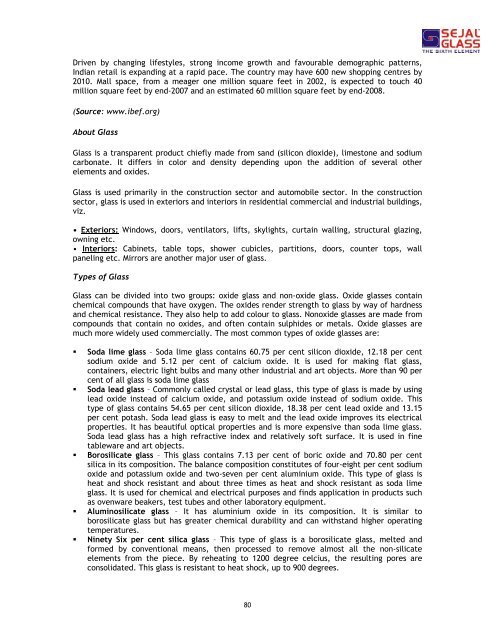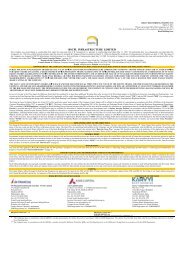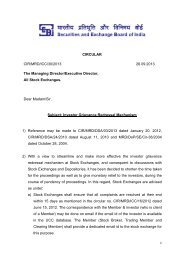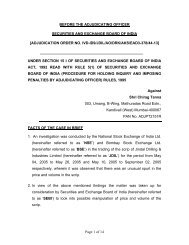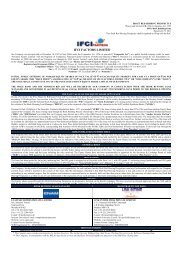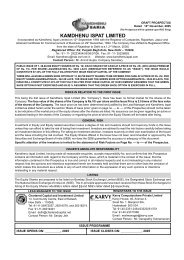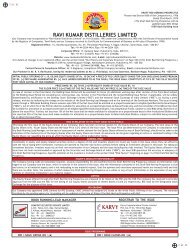sejal architectural glass limited - Securities and Exchange Board of ...
sejal architectural glass limited - Securities and Exchange Board of ...
sejal architectural glass limited - Securities and Exchange Board of ...
You also want an ePaper? Increase the reach of your titles
YUMPU automatically turns print PDFs into web optimized ePapers that Google loves.
Driven by changing lifestyles, strong income growth <strong>and</strong> favourable demographic patterns,<br />
Indian retail is exp<strong>and</strong>ing at a rapid pace. The country may have 600 new shopping centres by<br />
2010. Mall space, from a meager one million square feet in 2002, is expected to touch 40<br />
million square feet by end-2007 <strong>and</strong> an estimated 60 million square feet by end-2008.<br />
(Source: www.ibef.org)<br />
About Glass<br />
Glass is a transparent product chiefly made from s<strong>and</strong> (silicon dioxide), limestone <strong>and</strong> sodium<br />
carbonate. It differs in color <strong>and</strong> density depending upon the addition <strong>of</strong> several other<br />
elements <strong>and</strong> oxides.<br />
Glass is used primarily in the construction sector <strong>and</strong> automobile sector. In the construction<br />
sector, <strong>glass</strong> is used in exteriors <strong>and</strong> interiors in residential commercial <strong>and</strong> industrial buildings,<br />
viz.<br />
• Exteriors: Windows, doors, ventilators, lifts, skylights, curtain walling, structural glazing,<br />
owning etc.<br />
• Interiors: Cabinets, table tops, shower cubicles, partitions, doors, counter tops, wall<br />
paneling etc. Mirrors are another major user <strong>of</strong> <strong>glass</strong>.<br />
Types <strong>of</strong> Glass<br />
Glass can be divided into two groups: oxide <strong>glass</strong> <strong>and</strong> non-oxide <strong>glass</strong>. Oxide <strong>glass</strong>es contain<br />
chemical compounds that have oxygen. The oxides render strength to <strong>glass</strong> by way <strong>of</strong> hardness<br />
<strong>and</strong> chemical resistance. They also help to add colour to <strong>glass</strong>. Nonoxide <strong>glass</strong>es are made from<br />
compounds that contain no oxides, <strong>and</strong> <strong>of</strong>ten contain sulphides or metals. Oxide <strong>glass</strong>es are<br />
much more widely used commercially. The most common types <strong>of</strong> oxide <strong>glass</strong>es are:<br />
� Soda lime <strong>glass</strong> – Soda lime <strong>glass</strong> contains 60.75 per cent silicon dioxide, 12.18 per cent<br />
sodium oxide <strong>and</strong> 5.12 per cent <strong>of</strong> calcium oxide. It is used for making flat <strong>glass</strong>,<br />
containers, electric light bulbs <strong>and</strong> many other industrial <strong>and</strong> art objects. More than 90 per<br />
cent <strong>of</strong> all <strong>glass</strong> is soda lime <strong>glass</strong><br />
� Soda lead <strong>glass</strong> – Commonly called crystal or lead <strong>glass</strong>, this type <strong>of</strong> <strong>glass</strong> is made by using<br />
lead oxide instead <strong>of</strong> calcium oxide, <strong>and</strong> potassium oxide instead <strong>of</strong> sodium oxide. This<br />
type <strong>of</strong> <strong>glass</strong> contains 54.65 per cent silicon dioxide, 18.38 per cent lead oxide <strong>and</strong> 13.15<br />
per cent potash. Soda lead <strong>glass</strong> is easy to melt <strong>and</strong> the lead oxide improves its electrical<br />
properties. It has beautiful optical properties <strong>and</strong> is more expensive than soda lime <strong>glass</strong>.<br />
Soda lead <strong>glass</strong> has a high refractive index <strong>and</strong> relatively s<strong>of</strong>t surface. It is used in fine<br />
tableware <strong>and</strong> art objects.<br />
� Borosilicate <strong>glass</strong> – This <strong>glass</strong> contains 7.13 per cent <strong>of</strong> boric oxide <strong>and</strong> 70.80 per cent<br />
silica in its composition. The balance composition constitutes <strong>of</strong> four-eight per cent sodium<br />
oxide <strong>and</strong> potassium oxide <strong>and</strong> two-seven per cent aluminium oxide. This type <strong>of</strong> <strong>glass</strong> is<br />
heat <strong>and</strong> shock resistant <strong>and</strong> about three times as heat <strong>and</strong> shock resistant as soda lime<br />
<strong>glass</strong>. It is used for chemical <strong>and</strong> electrical purposes <strong>and</strong> finds application in products such<br />
as ovenware beakers, test tubes <strong>and</strong> other laboratory equipment.<br />
� Aluminosilicate <strong>glass</strong> – It has aluminium oxide in its composition. It is similar to<br />
borosilicate <strong>glass</strong> but has greater chemical durability <strong>and</strong> can withst<strong>and</strong> higher operating<br />
temperatures.<br />
� Ninety Six per cent silica <strong>glass</strong> – This type <strong>of</strong> <strong>glass</strong> is a borosilicate <strong>glass</strong>, melted <strong>and</strong><br />
formed by conventional means, then processed to remove almost all the non-silicate<br />
elements from the piece. By reheating to 1200 degree celcius, the resulting pores are<br />
consolidated. This <strong>glass</strong> is resistant to heat shock, up to 900 degrees.<br />
80


